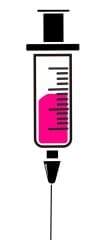Limited supply of COVID-19 vaccine in Monroe County: “We’ve been giving what we can give.”

Since Dec. 21, about 500 people a day in Monroe County have been getting their first of two required shots for the COVID-19 vaccine at the IU Health Medical Arts Building clinic.
The total number who have received that first shot now stands at 4,333.
That was the update given to Monroe County’s board of health members on Tuesday afternoon by Amy Meek, nursing supervisor for IU Health.
Based on that 500-per-day pace of COVID-19 shots, it would take a little over a year for 70 percent of the county’s roughly 150,000 residents to receive the required two doses of vaccine. The 70 percent figure has been cited as the minimum percentage needed to achieve herd immunity.
At Tuesday’s meeting, the pace of vaccination struck health board members as slow.
Asked for a breakdown of the bottlenecks, Meek said the problem is not staffing, it’s vaccine supply. “We’ve been giving what we can give.” She added, “We can’t have more appointments than the vaccine inventory that we have.”
Monroe County health administrator Penny Caudill said the 400 to 600 doses per week the county has been getting is more than the 100 doses a week she thought the county might receive.
Caudill said the state’s health department had reported on Tuesday that Indiana had received 300,000 doses of vaccine. Through Monday (Jan. 4) 114,000 doses had been administered, and about 130,00 more had been scheduled.
It’s just people in the Phase 1A category, which is frontline health workers, who are being invited to receive the vaccine right now.
The county’s emergency manager, Allison Moore, told The Square Beacon that the county’s emergency alert system would eventually be used to alert residents when mass POD (point of dispensing) sites are open.
Right now, in the early phases of the high priority vaccinations, the alert system will not be used, Moore said. “There are so many specific groups right now that it…could be confusing sending out the info.”
Christina Kempf, who’s public health coordinator for Monroe County, pegged the time frame for mass immunizations for the general public as starting in “late spring or early summer.”
Meek calculated the rate of vaccinations based on a vaccinator giving a shot every five minutes. At the Medical Arts Building, vaccinators had been working a 12-hour shift, Meek told the board.
Meek continued, “I’ll just tell you, working COVID since last March, I’ve never been so happy to work 12, 13, 14 hours a day right now, to give out a vaccine.” Meek added, “It really just feels good. It’s that light at the end of the tunnel we’ve all been waiting for.”
Meek said that in the next week, Monroe County is expecting 1,600 more doses—400 on Friday, possibly 600 on Monday. That means after next Monday, vaccinations could start being given through the public health clinic, Meek said. The public health clinic will conduct its vaccination operations out of the county convention center.
Christina Kempf, who’s public health coordinator for Monroe County, thanked the Monroe County public library and the Monroe County Consolidated School Corporation for lending the health department some iPads to help with the logistics and tracking for the administration of the vaccine. Kempf also thanked the Indiana Guard Reserve for help in logistical planning.
About the tracking of doses, Caudill said, “Every dose that goes into an arm is tabulated. And you don’t get more vaccine if you’re not using vaccine.”
The additional vaccine the county is expecting at the end of this week and the start of next week will allow vaccinations to start on Wednesday (Jan. 13) based out of a second location, which will be the county’s convention center. Meek said three vaccinators should be able to give about 300 shots a day in an eight-hour shift.
Added to the roughly 500 daily vaccine doses that IU Health is administering from the Medical Arts Building location would bring the total to about 800 a day.
The question of potential bottlenecks had been raised at the Tuesday board meeting by Stephen Pritchard. He pointed out that nationwide the same number of people who died in the 9-11 attack are dying every day of COVID-19.
“What does it take to set a fire under not just us, but everybody?” Pritchard asked. Pritchard continued, “We’ve just sort of grown accepting of: Well, that’s what happens. And we’re doing the best we can.” He added, “You know, the response hasn’t been quite what we’d hoped.”
The response that Pritchard got over the course of the meeting boiled down to a simple lack of vaccine supply.
The state’s department of health has set up a vaccination dashboard for tracking how many shots have been administered. The dashboard is updated every Wednesday.




Comments ()